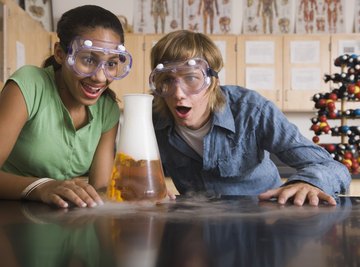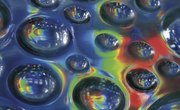
A water molecule has an uneven distribution of electron density. This uneven distribution is what makes water a polar molecule. There are several experiments that demonstrate the polarity of the water molecule, and the comparison of a nonpolar molecule can demonstrate the effect of polarity.
Surface Tension
Because of polarity, water molecules are pulled to the middle of a volume of water. This is why a drop of water will be rounded on the surface it is dropped on, which illustrates surface tension. To experiment with surface tension, use a penny, water and a dropper. Lay the penny on a flat surface and slowly drop water onto it. The water molecules stick together and form a convex shape on the penny, like a bowl placed upside down. This is due to the bonding or attraction of the positive and negative hydrogen molecules found in water. Try the same with oil, which is nonpolar.
Molecules in the Mix
Experiment on polarity and nonpolarity in a chemistry lab using a 12-well strip. Using a dropper, place 10 drops of water in seven wells. Place a few crystals of urea in one well, iodine in the next, ammonium chloride in the third, naphthalene in the fourth, copper sulfate in the fifth, sodium chloride in the sixth and five drops of ethanol to the final well. Mix the contents of each with a toothpick and record your observations. Repeat the process using 10 drops of vegetable oil (a nonpolar solvent) instead of the 10 drops of water and record your observations.
Charged Attraction
Water molecules have an uneven distribution of atoms, which is what makes them polar. The atoms in vegetable oil molecules are distributed evenly; this makes them nonpolar. Polar solutions, which have positive and negative charges on either end, will be attracted to a charge. To illustrate this, charge a balloon by rubbing it against a piece of wool, or your head. Turn a water faucet on so that there is a steady stream and hold the balloon near the stream of water. The water will pull toward the negatively charged balloon. Place the nonpolar oil in a paper cup that has a small hole in it and hold the balloon near the stream of oil. There is no attraction; therefore, the atoms are evenly distributed.
Troubled Trio
It is known that water and oil don’t mix because water is a polar solvent and oil is nonpolar. There are also molecules that have both polar ends and nonpolar ends -- detergent is one of these. Put water into a glass beaker and add oil to it; the oil, because it is lighter, will float on the top. Even when shaken or stirred, the oil will separate from the water and float back to the top. Add detergent. The detergent’s polar ends are attracted to the water and its nonpolar ends are attracted to the oil.
References
About the Author
June Farquhar has been writing for newspapers and special publications in California since 1998. She's the recipient of a press club award for organizing and designing a 42-page "Red Ribbon Week" tabloid, which received recognition from the California State Assembly and the U.S. House of Representatives. Farquhar studied newspaper journalism at Bakersfield College.
Photo Credits
Jupiterimages/Brand X Pictures/Getty Images
